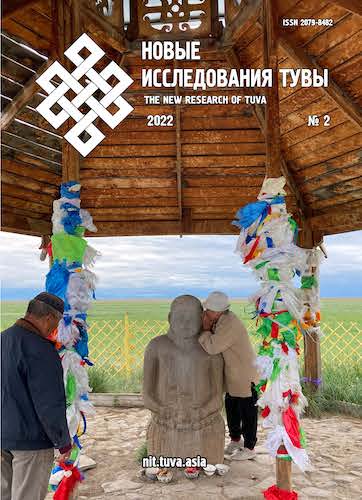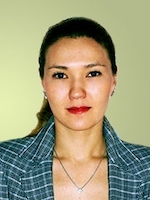Demographic processes in the towns of Kyzyl and Elista in 2011-2020: a comparative study
DOI:
https://doi.org/10.25178/nit.2022.2.3Keywords:
Tuva; Kalmykia; Kyzyl; Elista; migration; birth rate; mortality rate; age and gender structure of the populationAbstract
The article compares the de,ographic situation and related processes in Kyzyl and Elista, the capitals of two of Russia’s constituent republics — Tuva and Kalmykia, respectively. The authors have focused on the changes in three major demographic processes — fertility, mortality and migration — as well as demographic structures and behaviours. The authors have also calculated birth rates, migration indices (including age-specific rates) and examined the age and gender structure of the demographics, drawing up the demographic balance for both Kyzyl and Elista.
Despite their evident similarity due to comparable population size and its share in the grand total for the republic, both of which have complex ethnoconfessional structure, demographic processes at Kyzyl and Elista have their own specific features. In Kyzyl, a combination of natural population increase and migration-related decrease leads to an overall population rise. In Elista, on the contrary, the rise has recently notably slowed down, largely due to a much older demographics, with low birth rates and high mortality rates.
Applying the natural population movement rates (which are independent of age structure distortions) to the situation in each of the cities shows that the birth and mortality rates are higher in Kyzyl. In Elista both men and women, as well as the population in total, on average live longer. Migration patterns in both cities are similar, but Kyzyl features a more intense migration among the females, as well as higher departure rates among elder citizens, which helps optimize the population’s age structure.
Since access to statistical data on the municipal level has been limited until recently, and the methodology of analyzing these data has been underdeveloped, many of the methods and indicators have been for the first time apllied in this study to demographic processes in Kyzyl and Elista.
References
Abylkalikov, S. I. (2021) Osobennosti demograficheskogo razvitiia Tuvy: vklad migratsii v demograficheskii balans [Features of demographic development of Tuva: Contribution of migration to the demographic balance]. New Research of Tuva, no. 4, pp. 131–142. (In Russ.). DOI: https://www.doi.org/10.25178/nit.2021.4.10
Anaiban, Z. V. (2020) Sovremennaia migratsionnaia situatsiia v Respublike Tyva [Contemporary migration situation in the Republic of Tuva]. Sciences of Europe, no. 49–4 (49), pp. 62–66. (In Russ.).
Anaiban, Z. V., Guboglo, M. N. and Kozlov M. S. (1999) Formirovanie etnopoliticheskoi situatsii [Shaping the ethnopolitical situation]. Moscow, Center for the Study of Interethnic Relations RAS. Vol. 1: Ocherki istorii postsovetskoi Tuvy [Essays on the history of post-Soviet Tuva]. 420 p. (In Russ.).
Badmaeva, N. V. and Natsak, O. D. (2021) Sovremennaia trudovaia migratsiia iz Kalmykii i Tuvy: ekonomicheskie, sotsio¬kul’turnye i gendernye aspekty [Modern labor migration from Kalmykia and Tuva: economic, socio-cultural and gender aspects]. New Research of Tuva, no. 4, pp. 186–205 (In Russ.). DOI: https://www.doi.org/10.25178/nit.2021.4.14
Vishnevskii, A. G. (2014) Demograficheskaia revoliutsiia meniaet reproduktivnuiu strategiiu vida Homo sapiens [The demographic revolution is changing the reproductive strategy of Homo sapiens]. Demographic Review, no. 1(1), pp. 6–33. (In Russ.). DOI: https://doi.org/10.17323/demreview.v1i1.1825
Vishnevskii, A. G. (2016) Demograficheskie posledstviia Velikoi Otechestvennoi voiny [Demographic consequences of the Great Patriotic War]. Demographic Review, no. 3(2), pp. 6–42. (In Russ.). DOI: https://doi.org/10.17323/demreview.v3i2.1752
Gunaev, E. A., Badmaeva, N. V. and Kovanova, E. S. (2019) Indikatory sotsial'nogo neblagopoluchiia naseleniia: etnoregional'naia spetsifika Kalmykii, Buriatii i Tuvy [Social insecurity indicators: ethnoregional specifics in Kalmykia, Buryatia and Tuva]. New Research of Tuva, no. 1, pp. 190–201. (In Russ.). DOI: https://www.doi.org/10.25178/nit.2019.1.14
Denisenko, M. B. and Kalmykova, N. M. (2009) Demografiia [Demographics]. Moscow, INFRA-M. 432 p. (In Russ.).
Zakharov, S. V. (2017) Potentsial strukturnykh faktorov rosta rozhdaemosti ischerpan? Chast' pervaia [Is the potential of structural factors of fertility growth exhausted? Part one]. Demoskop Weekly, no. 731–732 [online] Available at: http://demoscope.ru/weekly/2017/0731/tema01.php (access date: 20.02.2022). (In Russ.).
Kashnitskii, I. S. (2014) Chto v vozraste tebe moem? [What's my age to you?]. Demoskop Weekly, no. 581–582 [online] Available at: http://www.demoscope.ru/weekly/2014/0581/tema01.php (access date: 20.02.2022). (In Russ.).
Lamazhaa, Ch. K. and Namrueva, L. V. (2018) Subetnicheskie differentsiatsii rossiiskikh etnosov (na primere kalmykov i tuvintsev) [Sub-ethnic differentiations of Russian ethnic groups: the case of Kalmyks and Tuvans]. New Research of Tuva, no. 2, pp. 206–226. (In Russ.). DOI: https://www.doi.org/10.25178/nit.2018.2.11
Mkrtchian, N. V. (2011) Dinamika naseleniia regionov Rossii i rol' migratsii: kriticheskaia otsenka na osnove perepisei 2002 i 2010 gg. [Population dynamics of Russia’s regions and the role of migration: Critical assessment based on the 2002 and 2010 censuses]. Regional Research of Russia volume, no. 5, pp. 28–41. (In Russ.). DOI: http://doi.org/10.1134/S2079970511030087
Mkrtchian, N. V. (2020) Problemy v statistike vnutrirossiiskoi migratsii, porozhdennye izmeneniem metodiki ucheta v 2011 g. [Problems of statistics of internal Russian migration caused by changes in accounting methods in 2011]. Demographic Review, no. 7(1), pp. 83–99. (In Russ.). DOI: https://doi.org/10.17323/demreview.v7i1.10821
Petrosian, A. N. (2021) Rozhdaemost' v munitsipal'nykh obrazovaniiakh Rossii v 2011–2019 gg. [Birth rates at the municipal level in Russia, 2011-2019]. Demographic Review, vol. 8, no. 3, pp. 42–73. (In Russ.). DOI: https://doi.org/10.17323/demreview.v8i3.13266
Tinikova, E. E. (2021) Urbanizatsiia natsional'nykh respublik Saiano-Altaia skvoz' prizmu teorii modernizatsii [Urbanization in the Sayan-Altai republics: A perspective from modernization theory]. Oriental Studies, no. 14(2), pp. 275–290. (In Russ.). DOI: https://doi.org/10.22162/2619-0990-2021-54-2-275-290
Chudinovskikh, O. S. (2021) K voprosu o sozdanii registra naseleniia i ispol'zovanii administrativnykh dannykh dlia nuzhd gosudarstvennoi statistiki [On the establishment of the Population Register and the use of administrative data for the benefit of public statistics]. Voprosy statistiki, no. 28(1), pp. 5–17. (In Russ.). DOI: https://doi.org/10.34023/2313-6383-2021-28-1-5-17
Shchur, A. E. (2018) Goroda-millionniki na karte smertnosti Rossii [Million-plus cities on Russia’s mortality map]. Demographic Review, vol. 5, no. 4, pp. 66–91. (In Russ.). DOI: http://doi.org/10.17323/demreview.v5i4.8663
Yumaguzin, V. V. and Vinnik, M. V. (2019) Problemy kachestva statistiki smertnosti v Rossii [Issues of quality of mortality statistics in Russia]. EKO, no. 10, pp. 54–77. (In Russ.). DOI: http://doi.org/10.30680/ECO0131-7652-2019-10-54-77
Yarmarkina, G. M. (2019) Kalmyki i tuvintsy v russkom diskurse XX — nachala XXI veka [Kalmyks and Tuvans in Russian discourse: 20th to early 21st centuries]. New Research of Tuva, no. 4, pp. 154–164. (In Russ.). DOI: https://www.doi.org/10.25178/nit.2019.4.13
Abylkalikov, S. (2016) Migration Activity and Adaptation of Russian Regional Populations. Regional Research of Russia, vol. 6, no. 4, pp. 357–365. DOI: http://doi.org/10.1134/S207997051604002X
Abylkalikov, S. I., Sazin, V. S. (2019) Migration in the Kaliningrad region reflected in the 1989–2015 censuses and microcensuses. Baltic Region, vol. 11, no. 2, pp. 32–50. DOI: https://doi.org/10.5922/2079-8555-2019-2-3
Dyson, T. (2011) The role of the demographic transition in the process of urbanization. Population and Development Review, vol. 37, no. 1, pp. 34–54. DOI: https://doi.org/10.1111/j.1728-4457.2011.00377.x
Karachurina, L. B. and Mkrtchyan, N. V. (2020) Age-specific Migration in Regional Centres and Peripheral Areas of Russia. Comparative Population Studies, no. 44, pp. 413–446. DOI: http://doi.org/10.12765/CPoS-2020-12en
Karachurina, L. B. and Mkrtchyan, N. V. (2021) Intraregional Population Migration in Russia: Suburbs Outperform Capitals. Regional Research of Russia, vol. 11, no. 1, pp. 48–60. DOI: http://doi.org/10.1134/S2079970521010068
Rogers, A., Watkins, J. F. and Woodward, J. A. (1990) Interregional Elderly Migration and Population Redistribution in Four Industrialized Countries A Comparative Analysis. Research on Aging, vol. 12, no. 3, pp. 251–293.
Timonin, S., Jasilionis, D., Shkolnikov, V. and Andreev, E. (2020) New perspective on geographical mortality divide in Russia: a district- level cross- sectional analysis, 2008–2012. Journal of Epidemiology and Community Health, vol. 74, no. 2, pp. 144–150. DOI: http://doi.org/10.1136/jech-2019-213239
Published
How to Cite
For citation:
Abylkalikov S. I. and Baimurzina G. R. Osobennosti demograficheskikh protsessov v gorodakh Kyzyl i Elista v 2011‑2020 gody: sravnitel’nyi analiz [Demographic processes in the towns of Kyzyl and Elista in 2011-2020: a comparative study]. New Research of Tuva, 2022, no. 2, pp. 34-52. (In Russ.). DOI: https://www.doi.org/10.25178/nit.2022.2.3
Issue
Section

This work is licensed under a Creative Commons Attribution-NonCommercial 4.0 International License.

Author(s) license holder(s) grant rights for their work to the journal (grantee of a license) under the simple non-exclusive open license in accordance with Art. 1286.1 «Open license for a research work, work of literature or fine arts», Civil Code of the Russian Federation.
New Research of Tuva publishes articles under the Creative Commons Attribution-NonCommercial license (CC BY-NC).
Since it is an open license, author(s) reserve the right to upload the article to their institutional repository, submit it to another journal (if it allows republications), or republish it on their own website (in full, or in part).
However, several conditions apply here:
a) The republished version must always contain the name(s) and affiliation(s) of the author(s), the original title and the hyperlink to the original version on the New Research of Tuva website;
b) It must be in open access, free of charge, and no category of readers must be in any way whatsoever advantaged over general readership.
c) should the contribution be submitted elsewhere by its author(s) without substantial modification (30% or more of original text unchanged), the body of the article should contain a disclaimer that the original version was published in New Research of Tuva (with a link to the respective page)
The CC-BY-NC is a non-revocable license which applies worldwide and lasts for the duration of the work’s copyright.










